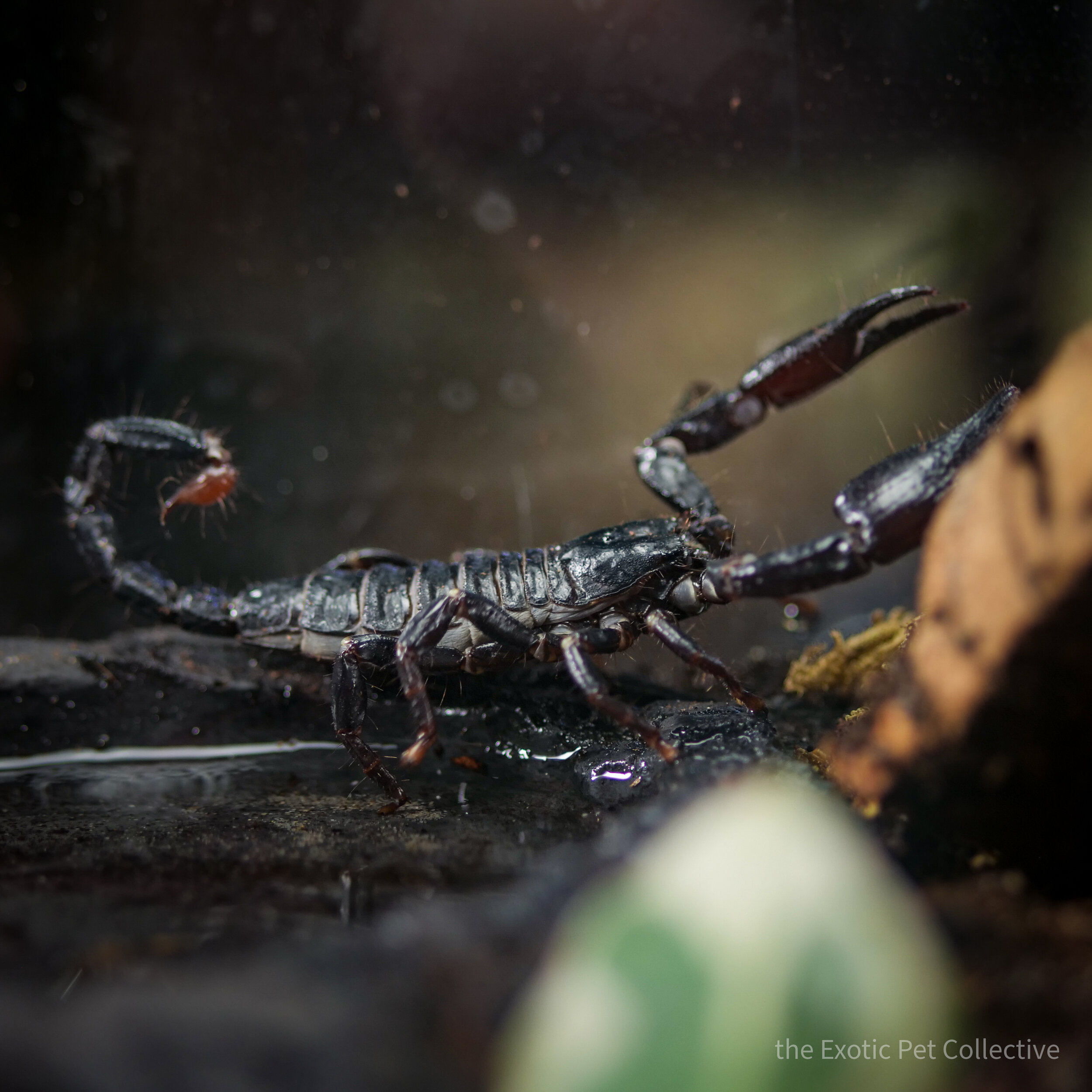Emperor Scorpion (Pandinus imperator) Care & Husbandry

Care & Husbandry Video
In this video I talk about exactly how I care for my Pandinus imperator. I detail how I set up my enclosures, feeding, and some general information and facts about the Emperor Scorpion
Scientific Name: Pandinus imperator
Common Name: Emperor Scorpion or Imperial Scorpion
Type: Terrestrial
Endemic Location: West Africa predominantly found in forests of Nigeria, Togo, Sierra Leone, Ghana and the Congo (can be as much as 8 inches)
SIze: 6-7 inches
Growth Rate: Medium
Life Expectancy: 6-8 years
Recommended Experience Level: Beginner
Venom: Low Potency not typically harmful to humans unless there is an allergy.
The Pandinus imperator, or Emperor Scorpion is a large scorpion that is native to Africa. These are one of the most popular scorpions in the hobby and can regularly be found in pet stores and reptile expos and favored as a great beginner species due to their size, temperament, ease of care, and low venom potency. They are not great for handling but they are amazing to watch. This species looks very similar to its cousin the Pandinus viatoris or the Red Cave Scorpion that is also from Africa but the Red Cave Scorpion seems to be a little smaller in size and their claws are more red in color and hints of blue. This species is also often mistaken with the Asian Forest Scorpion (Heterometrus spinifer) with many pet stores mislabeling them and selling Asian forest scorpions as Emperor scorpions. Asian Forest Scorpions are a little bit smaller and more territorial and slightly more aggressive than the P. imperator. Emperors have rough pincers, which also tend to be shorter but thicker than the Asian Forest. Asian Forest scorpions lack the red coloration that emperor scorpion pincers often exhibit, and their telson and aculeus are black, while emperor scorpions tend to have yellow to reddish yellow telson as juveniles that turn red as they mature. Even as babies there's a distinct visual difference, as emperor scorpion scorplings usually show quite visible red pigmentation in their pincers, which is completely absent in baby Asian Forest scorpions that are very black. The Emperor Scorpion grows about 6 inches in size, with some claiming up to over 7.5 inches and can live between 6-8 years. They may be the largest scorpion in the world, but the longest scorpion is actually the Flat Rock Scorpion.
Compared to other scorpions, the Emperor scorpion is not nearly as “hot” as other species, meaning its venom is not as dangerous or painful if you were to get stung. In fact, you probably wont feel much discomfort or have any serious problems unless you are allergic and have an anaphylactic reaction. In my experience, they seem much more likely to pinch you than try and sting you. Interestingly, some molecules that make up their venom are currently under research, as scientists believe that they could have properties against malaria and other harmful bacteria. They have large, powerful claw so a pinch could be painful but they are a mostly docile species and only attempt to pinch or sting when they feel threatened. The risk with handling this species is more due to the harm that could come to the scorpion than the harm they could inflict on the handler. Like tarantulas, scorpions can bolt short distances, usually faster than you can react. And they have an exoskeleton that is not designed to handle falls from substantial heights. They spend most of their time burrowed underground and coming out at night to crawl around on the surface. They are not arboreal, meaning they aren’t normally climbing high into trees. So when handling a scorpion, if it were to suddenly bolt, it is very possible that it could fall off your hand or arm and risk rupture once it hit the ground. So it is always best to avoid handling unless you take precautions like handling over a table or while sitting on the ground to greatly reduce the distance of a fall should the scorpion attempt to get away from you.
Pandinus imperator can be found in Africa and live in areas that are warm and humid. Naturally they prefer living in burrows they made from small rodents or snakes or digging out themselves. So when you set up their enclosure, these are 2 facts you need to keep in mind.
I keep my adult emperors in a 10 gallon aquarium filled at least half way or more with substrate. Knowing that they need a little humidity and will be digging burrows, I tend to use a mix of slightly damp coco fiber mixed with peat moss in a 50/50 ratio. I have also had a lot of success using Creature Soil or Jungle Mix pre made substrates and mixing in a little sand and few handfuls of sphagnum moss. I dampen the substrate so that it feels wet, but water does not come out when I squeeze it in my fist. I pack the substrate down slightly and provide two hides on opposite sides of the enclosure. I provide a large, but shallow water dish that I keep full of water. You don’t want to use a deep dish or one that the scorpion will have issues getting in and out of because they can drown if trapped in a large water dish. I will link the types of water dishes I have had success with down below in the description. These can be a bit of a hassle due to the fact the water evaporates quickly bc it is so shallow, but it is for the safety of your scorpion. I use 2 hides because I keep a dry side and a damp side in their enclosures. On the damp side I also add a nice nest of sphagnum moss in the corner to help keep humidity up, and when I notice the substrate drying out, I will water down that side so it gets saturated, but never swampy. The other side I will let dry out and I find my scorpion will alternate which hide it spends in time based on their preference at that time.
For the most part, this species can be kept at room temperatures between 69f - 75f, but some people prefer to add a little additional heat for their scorpions. If you keep their enclosures in the basement like I do, or in a cool part of the house or maybe it is just winter and the room temps are on the lower end of the acceptable range, you may consider adding an under tank heater. This seems to be hotly debated in the scorpion community because it can be dangerous if not done right. To escape heat and cool off, scorpions will usually retreat to their burrow and dig deeper because the deeper they go, the cooler it gets. If you use an under tank heater and actually place it under the tank, then it will actually get warmer the deeper the scorpion digs. So it is recommended you place the heat pad on the side of the enclosure to great a horizontal temperature gradient. The side the heat pad is on will be warmest right up against the glass and coolest on the other side against that wall. Having hides on either side of the enclosure gives them the choice of not only a damp hide and dry hide, but also a warm hide and a cool hide. Currently I am experimenting with two different layouts with my specimens. I have a heat pad on the dry side of one enclosure so there is a cooler, damp hide and a warmer dry hide. On the other it is reversed so there is a cool and dry hide and warm and damp hide. I have yet to notice any real preferences be exhibited, but I think putting the UTH on the damp side help keep the overall humidity a little higher and provides a slightly more tropical feel to the enclosure. You just have to be sure to remember to regularly water that side of the enclosure because it will be prone to dry out. Another important factor when using an under tank heater is that they are always on, so you should use a thermostat and place the sensor at the level your scorpion will be in its hide and plug the heat mat into that and set the temp to around 85-90f. I avoid using any heat lights as it is hard to regulate the temperature and it dries the air out considerably in the enclosure. You also need to make sure you have a tight fitting lid that can lock and is sturdy. These scorpions are strong and can lift the lid of an enclosure that isn’t tightly locked and squeeze through small spaces.
As far as feeding is concerned, I base it mostly off the appearance of the scorpion at all stages of life. For adults, I will feed them 3-4 large crickets or a medium dubia roach once a week. Once they begin to start looking plump, i will cut back on the amount and frequency. But if they are looking thin and seem very excited to take down their prey, I will increase the amount or size of the feeders I give them. For young scorpions, it is important to never attempt to feed them prey that is larger than they are. Typically I use feeders that are half their size, or no more than ¾ their size. And if they don’t eat the prey within 12-24 hours, I removed the prey so it doesn’t provide unneeded stress and try again in a week.
Due to the tropical environment in the enclosure, it is important to remove dead and uneaten prey or leftovers as soon as possible as that can attract mites, mold and gnats. Another option is to keep this species in a bioactive enclosure. Springtails will thrive in the damp substrate and work as a clean up crew to help break down any organic materials. Some people like to also include isopods, but that can be a little risky as isopods need calcium in their diet and there have been reports of them turning to the scorpion, especially one that is molting, to feed on them for their calcium. And if you include live plants, you will need light for the plants so you will need plenty of dark hides for your scorpion to retreat to.
There are some reports that this species can be kept in a communal enclosure successfully, but usually it is not recommended. Like most scorpions, they can be territorial and exhibit cannibalism if not well fed and kept in close proximity. If you keep 4 or 5 of them in a 20 gallon enclosure with a few more hides than there are scorpions and keep them well fed, you may be successful. Another reason it may not be recommended, because if you are keeping males and females together, you may end up with a lot of baby scorpions, more than you are prepared to care for. So only consider keeping them in a communal if you have done all your research and have kept a single specimen successfully for an extended amount of time.
Overall this is an awesome species and easy to take care of. They are hardy, large and fairly docile. They are gorgeous and a lot of fun to keep and watch. If you are looking for your first scorpion, this the Emperor Scorpion would be high on my list for you to check out.









